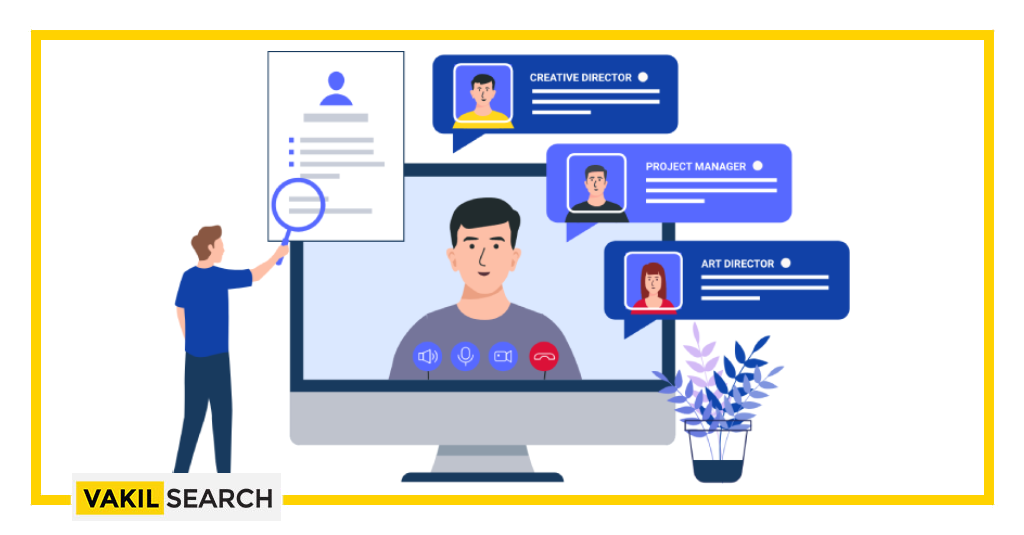In order to ensure the simple management of human resources, business processes, and data, a Human Resource Management system (HRMS) is a type of human resources (HR) software which is essential to have. Continue to read to learn more.
What is a Human Resource Management System (HRMS)?
A Human Resources Management System refers to a computer-based system designed to simplify and automate the administrative tasks performed by the human resources department. Companies use this software to combine various essential HR functions such as storing employee data, managing payroll, recruitment, benefits administration, time and attendance tracking, employee performance management, and keeping track of competency and training records.
By using such technology, HR professionals can monitor all business activities, automate routine processes, collect, store, and analyze data to make informed decisions about the company’s workforce. HR leaders and employees, who are responsible for daily personnel operations, compliance, and performance reporting, are the primary users of HRMS. However, other departments can also benefit. To attract younger hires, businesses can empower managers and staff with self-service for basic activities. Executives can use an HRMS to obtain information on worker trends and their impact on the organization.
Objectives of HRMS
The objectives of a Human Resources Management System (HRMS) include streamlining and automating HR processes, reducing manual effort and errors, improving data accuracy, and enhancing data analysis capabilities.
The system is designed to make HR tasks more efficient and effective, such as managing employee records, monitoring time and attendance, administering benefits and payroll, and tracking employee performance.
An HRMS can also support compliance with legal and regulatory requirements related to HR functions, such as equal employment opportunity, labor laws, and employee data privacy.
Additionally, an HRMS can provide valuable insights to HR leaders and executives by generating reports and analytics on workforce trends, turnover rates, and other key metrics.
Understanding of Human Resources Management System(HRMS)
Access to organisational resources is now quicker, safer, and more productive thanks to HRMS software. Additionally, it can be utilised to find out about an employee’s abilities, incentives, attendance records, leave requests, and more.
The HRMS’s primary characteristic of assisting management in employee monitoring is yet another important one. Payroll management, training and recruitment, data storage and saving, attendance tracking, performance evaluation, logistics analysis, and making suitable people-centric business choices are a few additional useful applications of the Human Resources Management System.
Background of HRMS
Payroll was the initial HRMS function to be digitised in the 1970s as businesses sought to automate the administration of their workforce. However, in order to calculate a worker’s salary, withhold deductions, issue a paper check, and keep track of payroll responsibilities, mainframe technology was required. The payroll process did not become entirely electronic until the early 2000s when direct deposit and employee self-service were widely used.
In the late 1980s, PeopleSoft was one of the first to develop a more comprehensive Human Resources Management System (HRMS) system. In addition to payroll, it provided features for managing employee records, hiring, tracking time and attendance, administering benefits, generating salary slips, paying salaries, compiling compliance reports, and other aspects of the employee lifecycle to assist HR professionals in automating more of the hiring process and improving workforce decisions.
Even more, HR tasks benefited from automation as the internet expanded in the late 1990s. For instance, computerized job boards took the role of paper-based help-wanted ads, offering recruiters and candidates additional channels for communication. By the 2010s, cloud computing had become widely used; HR teams at businesses of all sizes could now purchase a suite of applications without spending money on pricey computer hardware or hiring IT personnel to run and maintain the system.
History of HRMS
During the 1970s, as businesses sought to streamline the management of their workforce, the payroll function was the first to be computerized as part of the Human Resources Management System (HRMS). However, this required the use of mainframe technology to accurately calculate earnings, withhold deductions, print paper checks, and track payroll liabilities. It wasn’t until the early 2000s when direct deposit and employee self-service became widely adopted that the payroll process became completely electronic.
In the late 1980s, PeopleSoft was one of the first companies to introduce a more comprehensive Human Resources Management System (HRMS). Along with payroll management, this system provided a range of other features such as employee record keeping, recruitment, time and attendance tracking, benefits administration, compensation management, compliance reporting, and more. By automating various aspects of the employee lifecycle, PeopleSoft’s HRMS enabled HR professionals to make better decisions regarding their workforce.
In the late 1990s, the advent of the internet brought about further automation in HR processes, offering numerous benefits. For instance, traditional paper-based job advertisements were replaced by electronic job boards, which provided recruiters and job seekers with novel means to connect. With the widespread adoption of cloud technology in the 2010s, HR teams of all sizes could access a suite of applications without the need for expensive computer hardware or IT staff to operate and maintain the system.
HRMS Features
HRMS or Human Resources Management System is a software that enables organizations to manage their HR functions efficiently. It provides a centralized platform to manage employee data, payroll, benefits administration, and other HR-related processes. With the advent of technology, HRMS features have become more advanced and customizable, catering to the specific needs of organizations. In this article, we will discuss some of the essential HRMS features that can help organizations manage their employees better.
-
Benefits Administration
Benefits administration is one of the essential features of HRMS. It helps organizations manage employee benefits such as health insurance, retirement plans, and paid time off. With benefits administration in place, employees can easily access their benefits and make changes as needed. HRMS also helps in tracking the benefits usage, ensuring that employees receive the benefits they are entitled to.
-
Centralized Employee Records
Another critical feature of HRMS is centralized employee records. It enables organizations to store and access employee data in a centralized location, eliminating the need for multiple systems. Human Resources Management System (HRMS) enables employees to access their personal data, such as their contact information, work history, and performance evaluations, in a secure and confidential manner.
-
Learning Management
Learning management is a feature that allows organizations to manage their employee training and development. HRMS enables organizations to create, assign, and track employee training courses and certifications. It also provides employees with self-service access to training materials, allowing them to learn at their own pace.
-
Reporting and Analytics
HRMS also includes reporting and analytics features that enable organizations to analyze and evaluate their HR processes. It provides insights into employee data, such as turnover rates, performance metrics, and compliance, allowing organizations to make informed decisions. With the help of Human Resources Management System reporting and analytics, organizations can identify trends and patterns in their HR data, enabling them to take corrective actions when needed.
-
Talent Acquisition
HRMS includes talent acquisition features that help organizations attract, recruit, and onboard new employees. It enables organizations to create job postings, manage candidate applications, and schedule interviews. HRMS also helps in background verification and offers letter generation, simplifying the recruitment process.
-
Talent Management
Talent management is another essential feature of HRMS. It helps organizations manage their employee performance, development, and succession planning. Human Resources Management System enables organizations to set performance goals, provide feedback, and create development plans. It also helps in identifying high-potential employees, enabling organizations to create a succession plan for critical positions.
-
User Interface
HRMS provides a user-friendly interface that is easy to navigate. It simplifies the HR processes for both employees and HR personnel, enabling them to complete tasks efficiently. With the help of a user-friendly interface, organizations can reduce the time and effort required for HR processes, enabling HR personnel to focus on more critical tasks.
-
Workforce Planning
Workforce planning is an essential Human Resources Management System feature that enables organizations to plan their workforce requirements. It helps organizations determine their current and future staffing needs, ensuring that they have the right number of employees with the required skills. HRMS also enables organizations to create workforce scenarios, enabling them to evaluate the impact of different workforce strategies.
Benefits of an HRMS
-
Store Everything Together
Having all of your data in one place is highly advantageous for managing large volumes of employee information, procedural documentation, and more. A centralized location for HR data allows for the collection and tracking of all necessary details in a single location. This improves accessibility and reduces the risk of data loss when communicating between different teams or departments.
-
Be More Efficient and Productive
An HRMS system’s automation and support features significantly decrease the time spent on traditional HR functions. By reducing the workload of HR employees, they can focus on more critical tasks. Additionally, the data obtained from an Human Resources Management System can improve management and employee efficiency. Analyzing this data allows for proper employee placement in projects to optimize overall efficiency.
-
Employee Training and Self-service
Effectively training employees right from the start is a significant way to increase retention rates. However, ensuring their comfort with work processes in the ever-increasing digital age is not always easy.
Thankfully, HRMS software can help address this issue by providing access to online training materials. Identifying the workers’ needs is crucial for enhancing their skills, knowledge, and efficiency. With an HRMS system, you can set goals for individuals and teams, track their progress, and ensure everyone is on the same page.
Moreover, HRMS systems offer self-service capabilities to employees, which can enhance their engagement. This includes access to documentation, certificates, training materials, and new procedures, reducing the time spent by human resources in finding and delivering these documents.
This also makes benefit and compliance administration easier for everyone. Employees can easily check on their 401(k) plans or insurance benefits without having to go through HR. This makes communication much quicker, establishing direct lines between employees and their information.
-
Improved Hiring and Onboarding
Several HRMS (Human Resources Management System) software available in the market come equipped with tools that simplify the recruitment process, such as Integrated Applicant Tracking Systems. These tools streamline candidate searches, interviews, and evaluations, allowing you to work less to find the best talents for the job.
Organizing and tracking candidates in a centralized location through an HRMS simplifies the hiring process, saving time and reducing costs.
Onboarding becomes effortless with an HRMS system. New employees can easily access documents about work culture and procedures, while managers can follow up on background checks, employee evaluations, or probationary periods.
Communication and getting to know coworkers and the work environment are essential parts of onboarding. The HRMS system can introduce new employees to the team through notifications, help them stay updated on work events, and more.
Why is Human Resources Management System (HRMS) Needed?
A Human Resource Management System (HRMS) is needed because it helps organizations manage their human resources more efficiently and effectively. Here are some reasons why:
- Streamlining HR Processes: An HRMS automates many routine HR tasks, such as maintaining employee records, processing payroll, and tracking time and attendance. This reduces manual effort and errors, saves time, and improves accuracy.
- Enhancing Data Management: An HRMS helps organizations store and manage employee data securely, making it easier to access and update information. This improves data accuracy and eliminates the need for manual record-keeping.
- Enabling Better Decision-Making: An Human Resources Management System generates reports and analytics on workforce trends, performance, and other key metrics. This information helps HR leaders and executives make data-driven decisions that are aligned with organizational goals.
- Ensuring Compliance: An HRMS helps organizations comply with legal and regulatory requirements related to HR functions, such as equal employment opportunity, labor laws, and employee data privacy.
An HRMS provides employees with self-service options to access their personal information, such as benefits and payroll. This improves employee satisfaction and engagement by giving them more control over their HR-related tasks.
HRMS Security
When selecting a human resources management system, security is a significant concern. The data stored in an HRMS system is highly sensitive, including company proprietary information and extensive personal employee data. Therefore, it’s crucial for companies to choose a solution that utilizes a secure transmission method such as SSL, which encrypts the data during internet transmission.
Internal security is also critical; passwords must protect the information with varying levels of access according to job position requirements. While most companies allow employees to access certain parts of HRMS solutions, they must also understand the importance of maintaining system integrity and protecting its data security (e.g., no password sharing). Additionally, safeguards should be in place to immediately bar terminated employees from accessing the system.
Choosing an HRMS
The human resources management system (HRMS) market is highly fragmented, which can be overwhelming. Leading software review websites list over 700 companies providing HRMS. Evaluating them at a rate of two per day would take almost a year.
Therefore, the first step is to categorize potential providers into three groups:
Enterprise Resource Planning (ERP) providers incorporate integrations into their other business applications, such as accounting, customer relationship management (CRM), and procurement, to enjoy centralization benefits, such as entering employee records only once. With reduced integration costs, the ERP model offers a more consistent user experience and a single security model. It is no surprise that 95% of businesses have reported process improvements after implementing an ERP.
However, the downside of the ERP category is that you may not always find the same depth of features a Human Resources Management System specialist can offer. This means that certain tasks, such as running payroll, may need to be done by yourself. Additionally, user interfaces can be less user-friendly and more akin to an accounting interface than a consumer-grade social media experience.
Providers specializing in one to three areas of HRMS are known as best-of-breed providers. They offer a more comprehensive range of features with simpler user interfaces. However, the downside of using best-of-breed providers is that they may not provide a complete end-to-end Human Resources Management System system, and there may be additional costs if you require integration with other systems such as accounting. Additionally, the system may not be scalable enough to accommodate your company’s growth, so it’s important to ask about scalability.
To obtain a fully outsourced HR solution, service providers offer to take over HR tasks such as running payroll, administering benefits, ensuring compliance with regulations, and sending HR data to the accounting department for inclusion in financial reports. This allows companies to avoid having to employ as many HR specialists.
However, opting for such services comes at a higher monthly cost, can lead to less control over HR data and processes, and can be challenging to leave. Additionally, integrating the service with other systems may bring additional costs.
Why is HRMS Important for a Company?
For many Indian organisations, HRMS has made complicated duties simpler. It’s critical that HR professionals get more involved in corporate operations. However, given the organisation’s structure and scale, it can occasionally seem impossible to complete all the responsibilities without a fully developed, technologically advanced system.
Prior to Human Resources Management System (HRMS) integration, it’s crucial to evaluate both short- and long-term objectives. If some or all of the issues listed below are resolved, your organisation may benefit from investing in HRMS.
- A large amount of work for the HR department
- HR compliance mistakes could result in losses financially
- An unmanageable workforce that is distributed
- A rising rate of employee turnover
- Employees have few alternatives for tracking evaluations.
The HRMS maintains sensitive information. As a result, it is essential to put a system of security measures in place before purchasing one. Giving each employee a unique username and password is one method to improve security. Only the admin has access to the customised profiles. Access to HRMS portals should be disabled for terminated employees as soon as they resign.
When to Purchase an HRMS
Deciding when to implement or upgrade an Human Resources Management System is not a one-size-fits-all decision. Companies may consider purchasing or upgrading when they hire a new HR leader, expand into new regions, fail an audit, acquire a new accounting system, or undergo a merger or acquisition. Other reasons include new regulatory requirements, fast growth, or a need to plan for the future workforce.
The HRMS selection committee should include leaders from HR, finance, and IT departments. After narrowing down the options, it’s beneficial to involve a cross-section of employees who will be using the system to evaluate its interface and functionality. These employees can become system advocates once it’s implemented.
Components of HRMS Success
In summary, here are our five recommendations for getting the most out of a Human Resources Management System (HRMS) purchase:
If your IT strategy is forward-thinking, consider systems that currently use machine learning and predictive analytics and have a plan for implementing AI. The earlier you begin feeding the system data, the better it can predict future workforce needs and match candidates with positions.
Different HRMSs excel in different areas. If you have high turnover, evaluate candidate management capabilities. If you have a multi-state or multi-national workforce, ensure that the system can handle complex payroll scenarios. If you hire a lot of temporary workers but are considering switching to permanent employees, a contingent workforce management feature can aid in analysis.
Pitch the benefits of a Human Resources Management System in terms of retaining talent, freeing up HR staff for value-added projects, and reducing audit findings, rather than merely discussing the system’s features.
Involve your security team or consultant in the selection process early, particularly if your industry is highly regulated, such as finance or healthcare.
If you opt for the best-of-breed approach, search for open APIs that make integration feasible without the need for a costly development project.
How Does an HRMS Work?
An HRMS is a digital tool that helps an organization’s human resources department by automating manual tasks, organizing employee information, and generating data-driven reports. This eliminates the need for paper documents and allows for more efficient and accurate HR processes.
Since every business has unique needs, a Human Resources Management System typically offers customizable apps and features. Users can create their own login credentials to access the platform, and supervisors can tailor access permissions based on employee roles and responsibilities.
If an organization has multiple locations or HR supervisors, they can access the HRMS remotely from different locations and receive real-time updates on tasks related to recruitment, payroll, benefits, and more.
When a user updates information in the HRMS, the changes are automatically reflected across the platform and securely stored in the cloud. To further enhance its functionality, an HRMS can be integrated with other data management programs used by the company.
Functions of an HRMS
To choose the most suitable Human Resources Management System for your organization, it’s useful to consider its functional components. In general, contemporary HRMSs comprise seven areas, each with a different level of emphasis.
-
Candidate Management
Candidate management involves various aspects of the hiring process, including extending employment offers to candidates, promoting your brand to potential candidates and current employees who may be interested in internal job opportunities or referrals. This is particularly crucial for companies that prioritize the candidate experience. It encompasses tasks such as managing resumes, scheduling interviews, making job offers, and facilitating onboarding.
-
Employee Engagement
Employee engagement is crucial, as it correlates with higher-quality work and greater alignment with a company’s values and vision. The employee’s interactions with their colleagues and leaders play a significant role in fostering engagement. A Human Resources Management System can facilitate training courses, skill development, career pathing, recognition, and mentoring opportunities, making it an essential tool to boost employee engagement.
-
Optimisation
One of the main advantages of an HRMS is the ability to extract insights and develop a vision for the future workforce. However, this function is often underutilized in typical HRMS implementations. Its true value is evident during mergers and acquisitions, significant economic shifts, or executive departures. Organizations that proactively optimize their workforce tend to be more adaptable to change, retain top talent better, and have higher levels of employee engagement.
-
Payroll
Calculating employee earnings, from gross to net or net to gross, and managing individual deductions and payments is another crucial function of the Human Resources Management System. With this system, payroll functions, including benefit elections and both employee and employer costs, can be as routine as paying rent. Full-service payroll solutions also automate tax filing and deposits. Self-service options allow employees to make changes to elective deductions, direct deposit accounts, and tax withholdings, and access earning statements without needing HR assistance.
-
Employee Management
The reason this function is often referred to as “core HR” is that it provides a central portal for supporting analysis, reporting, and compliance processes. It is where organizational units, such as departments or locations, are structured, reporting relationships between managers and employees are defined, and payroll is aligned with accounting cost centers. This function is also where personal information is recorded and maintained, and it serves as the foundation for efforts to offer employee self-service, enhance reporting, and improve HR service delivery.
-
Workforce Management
In this function, HR teams can keep track of employee development, manager evaluations, and disciplinary actions. They can also ensure that the company provides a healthy and safe work environment, and manage compensation planning, performance management, learning, and incident recording functions. Time and attendance can be recorded here, and HR can develop timesheet structures, overtime rules, time-off policies, and approval chains in a way that maximizes automation, control, and efficiency. Additionally, the employee performance review process, which includes goal management, can be set up within this function.
-
Contingent Workforce Management
This function is closely linked to primary workforce management and is crucial for companies that do not have a full-time workforce. Contractors, consultants, interns, and temporary employees provide specific skills, support local community initiatives or university programs, and help manage spikes in labor demand. The Human Resources Management System (HRMS) does not entirely oversee these relationships as these employees are not always on the payroll and are usually not eligible for benefits. However, their work contributes to company success, and it’s important to monitor the number of contingent employees and their total costs at any given time.
HRIS vs HRMS
HRIS Systems |
HRMS Systems |
| HRIS stands for Human Resource Information System. | HRMS stands for Human Resource Management System. |
| It is primarily used to manage employee data, such as personal information, job titles, and pay rates. | It is a more comprehensive system that includes all the functionalities of an HRIS and also provides tools for managing the entire employee lifecycle, including recruitment, onboarding, performance management, training, and development. |
| HRIS is often used interchangeably with HRMS, but it typically refers to a more basic system that focuses on employee data management. | HRMS is a more advanced system that offers a wider range of functionalities and tools for managing HR processes. |
| HRIS can be useful for small to medium-sized businesses that primarily need to manage employee data and perform basic HR tasks. | HRMS is more suitable for medium to large-sized businesses with more complex HR needs, such as managing recruitment, performance, and training. |
| HRIS may not have all the features required to manage complex HR processes. | HRMS provides a more complete solution for managing HR processes. |
| Examples of HRIS software include BambooHR, Namely, and Zenefits. | Examples of HRMS software include Workday, Oracle HCM Cloud, and SAP SuccessFactors. |
HRMS FAQ’s:
How to choose the right HRMS for your organization?
To choose the right HRMS for your organization, you need to consider factors such as the size of your organization, the number of employees, the features and functionalities required, the budget and the level of customization needed.
Are there different types of HRMS solutions available in the market?
Yes, there are different types of HRMS solutions available in the market such as cloud-based HRMS, on-premise HRMS and hybrid HRMS.
How does HRMS integrate with other business software?
HRMS can integrate with other business software such as accounting software, CRM software, and project management software through APIs and other integration tools.
What is the average cost of implementing an HRMS?
The cost of implementing an HRMS can vary depending on the size of the organization, the features and functionalities required, and the level of customization needed. On average, the cost can range from a few thousand ruppees to several lakhs.
Is cloud-based HRMS better than on-premise solutions? Why?
Cloud-based HRMS is better than on-premise solutions in terms of scalability, accessibility and cost-effectiveness. Cloud-based HRMS can be accessed from anywhere and the cost of maintenance and upgrades is lower than on-premise solutions.
How to ensure the data in HRMS remains secure and confidential?
To ensure the data in HRMS remains secure and confidential, you need to implement security measures such as access controls, data encryption and regular backups. You also need to ensure that the HRMS complies with data privacy regulations such as GDPR and CCPA.
What are the trends in HRMS technology for the coming years?
The trends in HRMS technology for the coming years include the use of AI and machine learning for HR analytics, the integration of HRMS with other business software and the use of mobile and social technologies for employee engagement.
How does HRMS impact employee engagement and satisfaction?
HRMS can impact employee engagement and satisfaction by providing employees with easy access to HR information, enabling them to manage their own HR tasks, and providing them with tools for collaboration and communication.
Can small businesses benefit from HRMS or is it just for large corporations?
Small businesses can benefit from HRMS by automating HR tasks, improving HR processes and providing employees with easy access to HR information. HRMS can also help small businesses save time and money and improve employee engagement and satisfaction.
How often should a company update or upgrade its HRMS?
A company should update or upgrade its HRMS as needed to ensure that it remains up-to-date with the latest features and functionalities and complies with data privacy regulations.
What kind of training is needed to use an HRMS effectively?
The training needed to use an HRMS effectively depends on the complexity of the system and the level of customization needed. Typically, training can be given through online tutorials, user manuals and on-site training sessions.
Conclusion
An HRMS is a computer-based system that helps automate administrative tasks in the human resources department. Its goals include streamlining HR processes, reducing errors, improving data accuracy, ensuring compliance, and providing insights to HR leaders. HRMS helps manage human resources efficiently by enhancing data management, decision-making, employee experience, and compliance. It offers customizable apps and features and functions such as candidate management, employee management, payroll, benefits administration, performance management, compliance management, and reporting. HRMS history dates back to the 1970s when payroll was the first function to be computerized, followed by more comprehensive HRMS in the late 1980s. With the internet and cloud technology, HR teams of all sizes can now access the system remotely without expensive hardware or IT staff.










